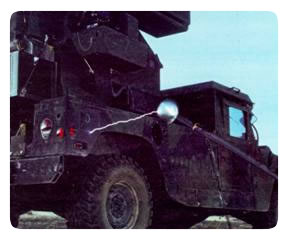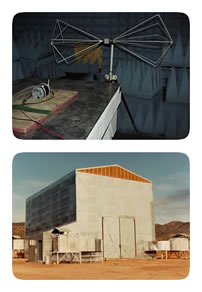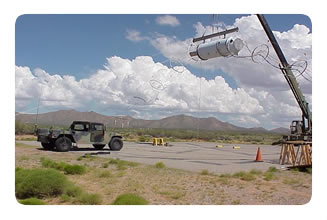- Home >
- Testing >
- Testing and Evaluation >
- Laboratories and Facilities >
- Electromagnetic Test Facilities
Electromagnetic Test Facilities
Survivability, Vulnerabilty, and Assessment Directorate (SVAD) - Electromagnetic Environmental Effects (E3) Test Facilities
The SVAD operates extensive Electromagnetic (EM) Environmental Effects (E3) Test facilities to support the requirements for test and evaluation of weapons systems while being subjected to electromagnetic environments.
WSMR´s growing, diverse customer base now includes multi-national companies from the private sector, leading research and development universities, Department of Defense (DoD) and other U.S. Government agencies, and various friendly, foreign governments. The critical core of WSMR is a seasoned staff of scientists, engineers, technicians, and other professionals whose consummate skills in comprehensive survivability and vulnerability simulation, test, evaluation, and assessment are coupled with their dedication to providing complete, quality customer support. Specific areas of expertise include nuclear and EW/EO/EM effects simulation, test, evaluation, and assessment; life cycle survivability assessment; transient radiation effects on electronics (TREE) testing; and test technology, instrumentation, and maintenance of a comprehensive survivability database. The EW/EO/EM test facilities include the Electromagnetic Pulse and Electromagnetic Radiation facilities at WSMR, the Pulsed Laser Vulnerability Test System (PLVTS) at WSMR's High Energy Laser Systems Test Facility (HELSTF) site, and the Lightning Test Facility (LTF), also at WSMR.
These facilities, coupled with the equally impressive technical and engineering capability of the WSMR professional staff, provide the basis for the Directorate's established competency in EW/EO/EM effects simulation, testing evaluation, and assessment.
Please contact us at
1-866-532-9767
or
usarmy.wsmr.atec.list.team-white-sands@army.mil
Electromagnetic Survivability Division
(505) 678-8341 or (505) 678-6107
DSN 258-8341
Electromagnetic Compatibility
The increasing complexity of weapon systems has lead to system comprised of multiple electronic, electric, or electromechanical subsystems. Inherent in this situation is the possibility that the emissions of one subsystem will degrade the performance of another and thereby have a negative impact on the entire system as a whole. The purpose of EMC testing is to explore and document this phenomenon. All EMC testing conducted at WSMR is performed in accordance with MILSTD-E-605D.

Entire Body Uniform Illuminations at:
Full Threat
Spot Illumination
AM, FM, PM and CW Modulations.
Three Separate Turntable Sites
Very Large Radiated Emissions (RE) Test Cell
Electrostatic Discharge
 Electrostatic discharge (ESD), or static electricity, as it is commonly known, can be potentially devastating to sensitive electronics. To ensure that weapon systems are hardened against damage from ESD, WSMR has the capability to perform both personnel-level (25,000 volts direct current [VDC]) and helicopter-level (350,000 VDC) ESD testing. Both tests are performed in accordance with TOP 1-2511.
Electrostatic discharge (ESD), or static electricity, as it is commonly known, can be potentially devastating to sensitive electronics. To ensure that weapon systems are hardened against damage from ESD, WSMR has the capability to perform both personnel-level (25,000 volts direct current [VDC]) and helicopter-level (350,000 VDC) ESD testing. Both tests are performed in accordance with TOP 1-2511.
The personnel-level ESD simulator used at WSMR is hand portable, which allows for discharge at any point on a system under test. Helicopter-level tests are performed by placing the item under test on nonconductive blocks, attaching one pole of a DC power supply to the item, and bringing a ground wand near enough to the test item to discharge the electrical charge.
Both personnel-level and helicopter-level ESD testing is done on a go/no-go basis; i.e., a system passes if it remains operational and safe after exposure to the ESD; otherwise, the system fails.
These helicopter tests are critical because helicopters and the items they transport can build up large charges of static electricity, as high as 350,000 VDC, as they fly through dust storms, winds, and clouds. When the helicopter lands, this electricity can discharge and cause extensive damage.
Electromagnetic Radiation Hazards

Hazards of Electromagnetic Radiation to Ordnance (HERO) testing is performed at the Electromangetic Radiation Effects (EMRE) facility. Also, Hazards of Electromagnetic Radiaiton to Fuel (HERF) and Hazards of Electromagnetic Radiation to Personnel are testing that can be performed.

Electromagnetic Interference Facility
WSMR conducts EMI testing to precisely measure the EM emissions from a system and to subject the test item to external radio frequency (RF) signals to determine the item's susceptibilities to EMI. At either of two facilities, an entire battery of EMI testing can be performed, including radiated emissions, radiated susceptibilities, conducted emissions, and conducted susceptibilities, and in compliance with applicable military standards (MIL-STDs).
 Electromagnetic Pulse Facility
Electromagnetic Pulse Facility
The Horizontally Polarized Dipole II (HPD-II) is a high-level-pulse, high frequency, hybrid EMP simulator that combines features and qualities of radiating simulators with those of transmission line/bounded wave simulators. A half-toroidal antenna with a major radius of 6 m and a minor radius of 0.77 m, the HPD-II provides horizontally polarized DoD STD 2169A E-1 environments for weapons systems located on the earth's surface.
Lightning Test Facility

Lightning strikes the earth, on average, more than 100 times each second. The typical lightning stroke is six miles long. The temperature of the return stroke, or primary flash, can reach 50,000 degrees Fahrenheit, or nearly five times hotter than the surface of the sun. Property losses from lightning total in the hundreds of millions of dollars each year in the commercial and private sectors alone. Losses to military facilities and equipment are equally high and can only be expected to rise as semiconductor devices, which are inherently more susceptible to lightning effects, are increasingly used in military equipment. To facilitate the study and mitigation of this devastatingly powerful natural phenomenon, WSMR has installed a Lightning Test Facility (LTF) to simulate the direct and indirect effects of lightning strikes.
Direct effects of lightning include burning, eroding, blasting, and structural deformation caused by lightning arc attachment, as well as by the high-pressure shock waves and magnetic forces produced by the associated high currents. Indirect lightning effects are predominantly those resulting from the interaction of the electromagnetic fields accompanying lightning with electrical devices.
Working with the LTF, WSMR engineers have developed a lightning effects test capability in accordance with MIL STD-1757A, which establishes standards for the waveforms used to determine direct and indirect effects of lightning strikes.
